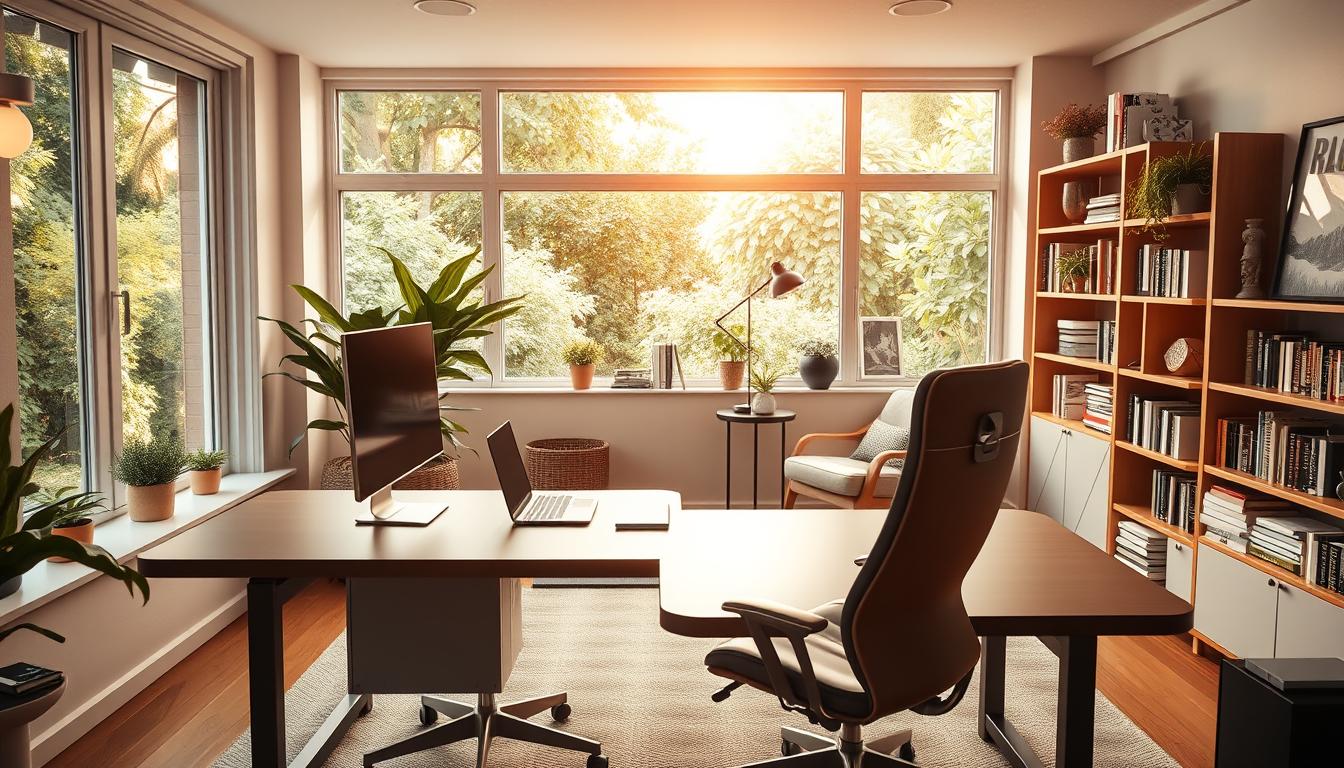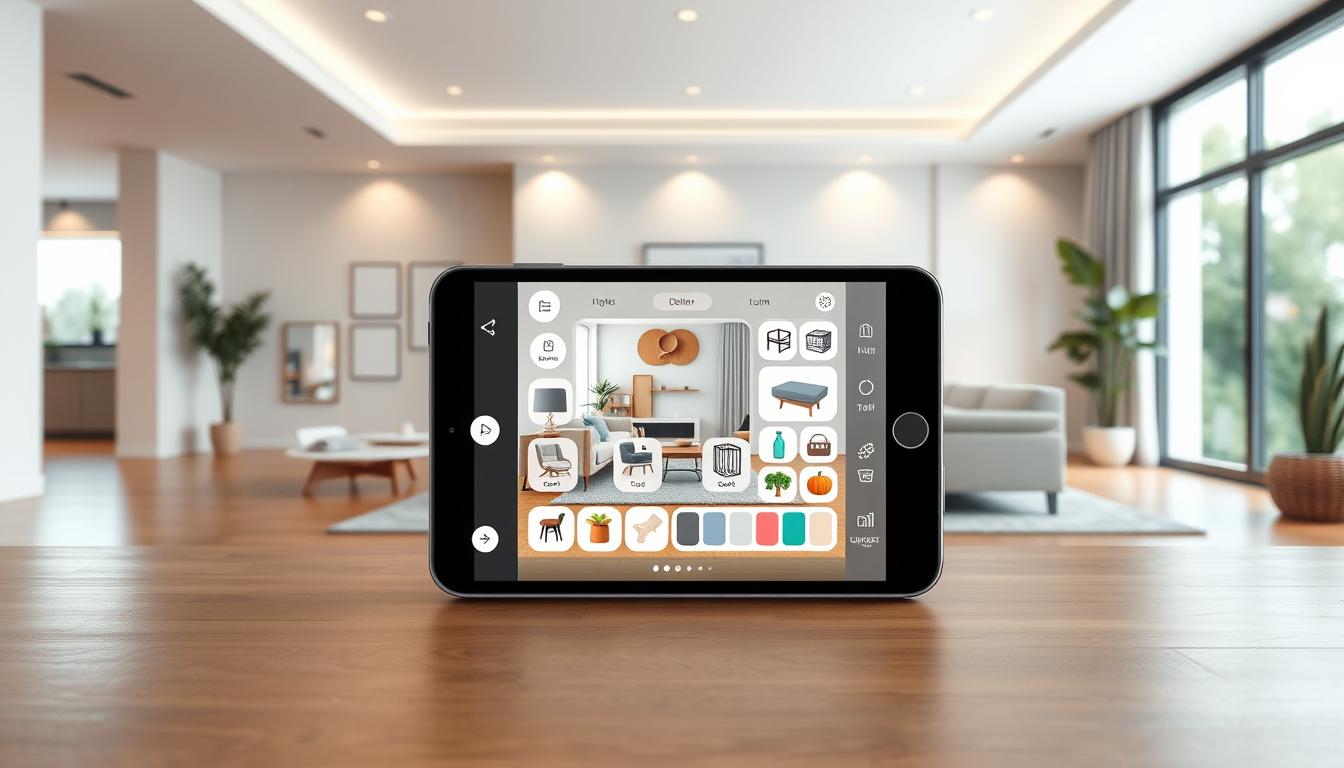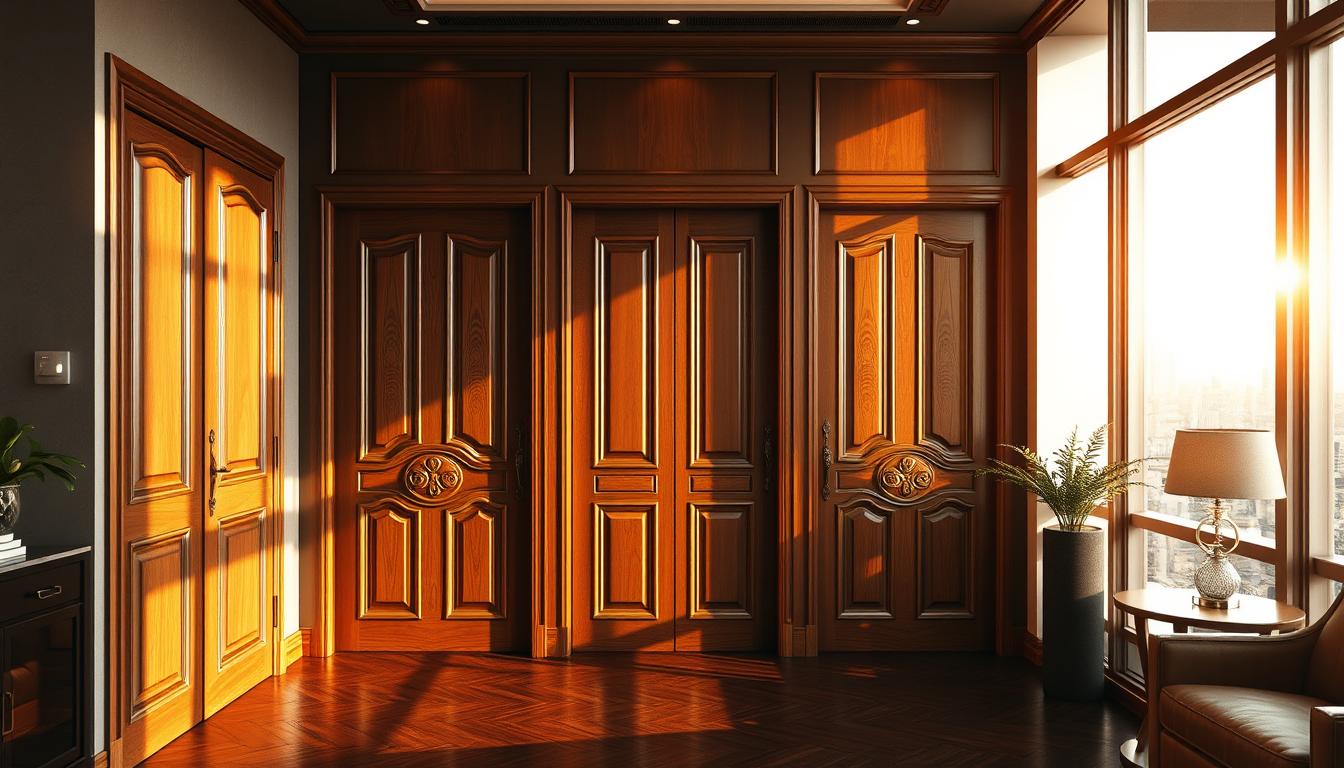A well-designed workspace can greatly improve our work efficiency and job satisfaction. Studies show that a messy workspace can lower productivity and increase stress.
Creating an ideal home office is more than just setting up a desk in a quiet spot. It needs careful thought about the space’s layout, lighting, and decor. This helps create a productive environment. By using effective office decor ideas, we can improve our focus and work quality.
As we dive into home office interior design, we’ll find useful tips and ideas. These will help turn our workspace into a productive haven.
Key Takeaways
- Understand the importance of a well-designed home office for productivity.
- Learn how to create an ideal workspace layout.
- Discover effective office decor ideas to boost focus and efficiency.
- Explore the role of lighting in enhancing work quality.
- Find inspiration to transform your workspace into a productive haven.
Assessing Our Space and Needs
Understanding our space and needs is key to a great home office. We must look at the room’s size and layout. We also need to think about the natural light it gets.
Evaluating Room Size and Layout
When checking the room’s size and layout, we should think about how to use the space well. Measuring the room and making a floor plan helps us see how it can be arranged. It’s also important to consider the traffic flow to ensure we can move around easily.
Identifying Functional Zones
A good home office has different areas for working, reading, and storing supplies. Identifying these zones helps us organize better. We can use room dividers or furniture arrangement to create these areas without making the space feel small.
Considering Natural Light Sources
Natural light is very important for a productive home office. We should look at the natural light sources and place our workspace to get the most benefit. A desk near a window can make us feel better and work better. But, we should also use light-filtering curtains to control the light and avoid glare on our screens.
By carefully looking at our room’s size and layout, identifying different areas, and thinking about natural light, we can make a home office that works well and looks good. This careful planning helps us stay organized and focused, making us more productive.
Choosing the Perfect Color Palette
Starting a stylish home office design means picking the right color palette. This palette should make our space feel productive and modern. The colors we pick can really change how we feel and focus.
Impact of Color Psychology
Color psychology is key in setting the mood of our workspace. Different colors can make us feel different ways and affect our work. For example, blue brings calm and trust, while green helps balance and harmony.
Warm colors like orange and red boost creativity and energy. On the other hand, cool colors like blue and purple help us relax and focus better.
“Colors are the smiles of nature.” –
Knowing how colors affect us helps us choose the best colors for our home office.
Popular Color Schemes for Home Offices
Many color schemes are popular for home offices. They look good and have psychological benefits. Some top ones are:
- Monochromatic: Using different shades of one color for a unified look.
- Complementary: Pairing colors that are opposite each other for contrast and interest.
- Analogous: Choosing colors next to each other for a smooth transition.
| Color Scheme | Description | Psychological Impact |
|---|---|---|
| Monochromatic | Different shades of a single color | Cohesive, harmonious |
| Complementary | Colors opposite each other on the color wheel | Contrasting, visually stimulating |
| Analogous | Colors next to each other on the color wheel | Smooth, natural transition |
Using Accent Colors Wisely
Accent colors can make our home office pop. But, we should use them carefully to avoid too much. Here’s how:
- Pick an accent color that goes well with the main colors.
- Use accent colors in small ways, like in vases, rugs, or art.
- Follow the 60-30-10 rule: 60% main color, 30% secondary, and 10% accent.
By picking the right colors and using accent colors smartly, we can make a home office that looks great and helps us work better.
Selecting the Right Furniture
The right furniture is key to a great home office. It affects both comfort and how well we work. Good furniture makes our workspace look good and helps us stay healthy and productive.
Ergonomic Chairs and Desks
Ergonomic furniture is vital for comfort and health during long work hours. An ergonomic chair supports our back, helping us stay upright and avoid back pain. An ergonomic desk lets us work comfortably, whether sitting or standing.
When picking an ergonomic chair, look for adjustable height, lumbar support, and breathable fabric. For desks, choose ones that let you stand or have cable management to keep things tidy.
Multi-Functional Furniture Options
In small home offices, multi-functional furniture is a big help. These pieces do more than one thing, making the most of our space. For instance, a storage ottoman can be a seat and a place to store things. A desk with shelves keeps our area organized.
Importance of Storage Solutions
Good storage is crucial for a tidy and productive home office. It keeps our space organized, cuts down on distractions, and boosts our efficiency. Use file cabinets, shelves, and bins to keep supplies and papers in order.
| Furniture Piece | Benefits | Considerations |
|---|---|---|
| Ergonomic Chair | Promotes good posture, reduces back pain | Adjustable height, lumbar support, breathable fabric |
| Multi-Functional Desk | Maximizes space, enhances functionality | Built-in storage, cable management system |
| Storage Solutions | Keeps workspace organized, reduces distractions | File cabinets, shelves, storage bins |
Choosing the right furniture for our home office is important. It makes our space both useful and nice to look at. Whether our office is big or small, the right furniture boosts our work performance and comfort.
Incorporating Technology Seamlessly
Integrating technology smoothly is crucial for a productive home office. As we work from home more, the right tech boosts our efficiency and work satisfaction.
Essential Gadgets for Productivity
We need the right tools to stay productive. High-performance computers, high-speed internet, and noise-cancelling headphones are key. They help us focus and work better.
- A reliable computer or laptop that meets our processing needs
- A high-speed internet connection to facilitate communication and data transfer
- Noise-cancelling headphones to minimize distractions
- A multifunctional printer for printing, scanning, and copying documents
For more ideas on creating the perfect home office, visit Luxe Interior Co. to explore contemporary home office designs.
Cable Management Strategies
Keeping cables organized is key for a tidy home office. Here are some tips:
- Use cable ties or zip ties to keep cables organized
- Implement a cable management box to hide excess cables
- Label cables to easily identify which cable is connected to which device
- Route cables behind furniture or through cable management channels
Smart Home Office Devices
Smart devices can make our home office better. They include:
| Device | Functionality | Benefits |
|---|---|---|
| Smart Lighting | Adjusts lighting based on the time of day | Reduces eye strain and improves mood |
| Smart Thermostats | Regulates temperature for optimal comfort | Enhances comfort and productivity |
| Voice Assistants | Provides hands-free control over various tasks | Increases efficiency and reduces distractions |
By adding these technologies and strategies, we can make our home office better. It becomes more functional and comfortable, boosting our productivity and work experience.
Personalizing with Decor
Adding thoughtful decor to our home office can really make it better. By choosing items that show our personality, we create a space that’s both useful and inspiring.
Choosing Inspirational Artwork
Artwork can change how our home office feels. Choosing pieces that inspire us boosts creativity and motivation. Pick art that matches our style or interests.
- Abstract art for a modern, dynamic feel
- Nature-inspired prints for a calming atmosphere
- Motivational quotes to boost productivity
When picking art, think about the colors. Make sure they match our stylish home office design.
Adding Personal Touches
Adding personal touches makes our home office feel more welcoming. This could be family photos, personal mementos, or collectibles that share our story.
It’s key to balance personal items with home office organization. Our personal touches should not clutter the space.
The Role of Greenery and Plants
Adding greenery and plants to our home office is great. They improve air quality and make the space look better. Plants like succulents or snake plants are easy to care for indoors.
When picking plants, think about where they’ll go. They should fit well with our interior decorating home office plans. We can put them on desks, shelves, or even hang them to add interest.
Optimizing Lighting for Work
A well-lit home office is key to our work efficiency and happiness. Lighting affects our productivity, comfort, and work quality. Knowing about different lighting types helps us create the best work space.
Types of Office Lighting
In a home office, we have three main lighting types: ambient, task, and accent. Ambient lighting lights up the whole room. Task lighting focuses on specific areas, like our desk. Accent lighting highlights special features or adds visual appeal.
Ambient lighting comes from overhead lights or natural light. Task lighting, like desk lamps, is for focused work. Accent lighting draws attention to certain items or features.
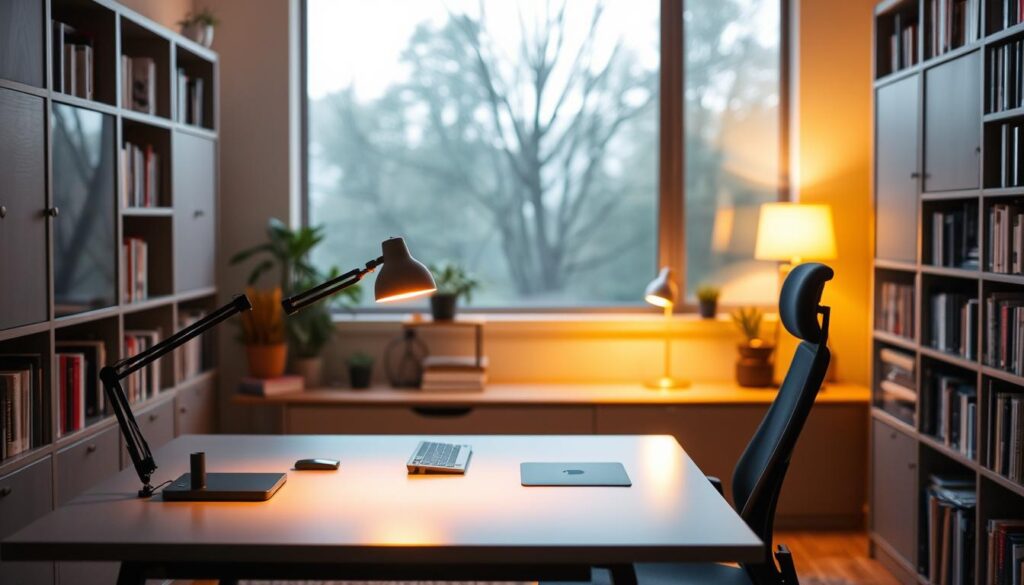
Balancing Natural and Artificial Light
It’s important to mix natural and artificial light for a comfy and productive space. Natural light is good for us and saves energy. But, it changes throughout the day. Artificial light helps fill in when natural light is low.
Place your desk near a window for natural light. Use artificial light to fill in the gaps. This combo reduces eye strain and makes the room feel better.
Task Lighting for Focus
Task lighting is crucial for focused work. It shines directly on the work area, easing eye strain and improving sight. Desk lamps are great for this, as they’re flexible and adjustable.
When picking a desk lamp, think about adjustability, brightness, and color temperature. A lamp with a high Color Rendering Index (CRI) shows colors accurately. This is important for tasks needing color precision.
Creating a Distraction-Free Environment
Keeping distractions away is crucial for a productive workspace. A well-designed home office boosts our focus and efficiency.
Soundproofing Techniques
Soundproofing is a great way to cut down on distractions. We can add mass to walls, use acoustic panels, or seal gaps to block out noise.
Adding acoustic panels to our home office decor does more than just reduce echo. It also brings a modern look to our space.
Decluttering Strategies
A messy workspace can really distract us. To keep our home office tidy, we need good decluttering strategies.
- Regularly sort through paperwork and digital files.
- Use storage solutions like filing cabinets and shelves.
- Keep things you use often within easy reach.
Decluttering helps us focus better and lowers stress. This makes our work environment more productive.
Using Room Dividers
In open-plan homes or shared spaces, room dividers are a must. They help create a dedicated workspace free from distractions. Room dividers are both useful and stylish, acting as a visual wall between different areas.
A chic room divider can divide our home office from the living area. This creates a clear boundary and reduces distractions.
By using these strategies, we can make a space that’s free from distractions. This supports our work goals and boosts productivity.
Maintaining a Professional Look
To look professional, our home office needs to be organized and stylish. A modern home office design boosts our productivity and shows a professional image to others. By adding office decor ideas that show our style, we make a space that works well and looks good.
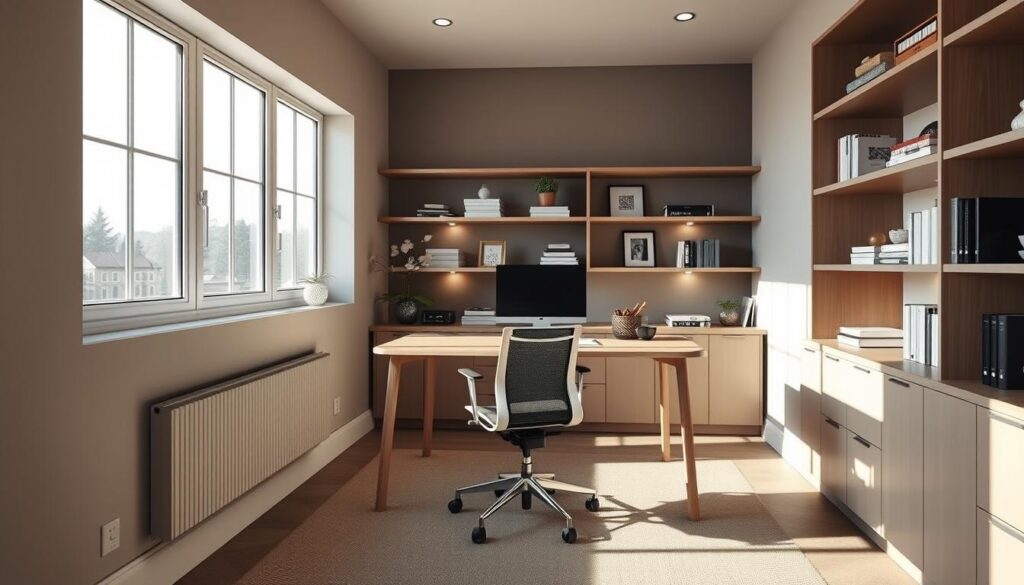
Tips for Organizing Supplies
Keeping our supplies organized is key to a professional home office. We can use storage like file cabinets, desk organizers, and shelves. This helps us work better and impress clients who visit.
Here are some ways to organize supplies:
- Use labeled folders and containers for documents and materials
- Handle paperwork right away with a “touch once” policy
- Keep often-used supplies close to avoid distractions
Keeping Virtual Backgrounds in Mind
Virtual backgrounds are important for remote work. Make sure your background is clean and professional for video calls. A simple colored wall or a professional backdrop works well.
To look good online, remember:
- Good lighting is key to show your face well
- Use a high-quality webcam for better video
- Avoid backgrounds that are too busy or distracting
Making Space for Client Meetings
Having a dedicated meeting area is crucial for client meetings. Make sure this space is well-lit, comfy, and free from distractions.
Here’s how to set up a meeting space:
- Choose stylish and comfy furniture that shows your professional side
- Keep decor professional and tasteful, avoiding too much personal stuff
- Keep the space clean and organized to impress clients
Implementing Organizational Systems
A well-organized home office boosts our work efficiency. To get there, we must set up systems that fit our needs.
Utilizing Wall Space
Using wall space is a smart way to organize our home office. Shelves, hooks, or pegboards can keep things tidy. For example, wall-mounted shelves can hold books, binders, or office supplies.
Digital Organization Tools
In today’s world, tech is key for an organized home office. Digital tools like project management software and apps help us stay organized. Experts say these tools cut down on paper clutter and make task management easier.
“The key to a productive home office is not just about physical organization but also about leveraging digital tools to streamline our workflow.”
Tools like Trello, Asana, and Evernote are great for staying on task. They help us keep track of deadlines and work together smoothly.
Scheduling and Planning Methods
Good scheduling and planning are crucial for a well-organized home office. Planners, calendars, or apps help us plan our work. For more ideas, check out Luxe Interior Co. for design tips.
Having a schedule helps us focus and balance work and life. It’s important to update our plans often to keep them working well.
Reviewing and Revamping Our Office
Creating a productive workspace is key. We need to regularly check and update our office. A well-designed home office boosts our productivity and work experience.
By adding modern decor and stylish design, we can make a space that sparks creativity and focus.
Productivity Assessments
Regular checks on productivity help us find ways to improve our home office. We can look at our workflow, change our layout, and make updates to make our space better.
Refreshing Decor
Knowing when to update our decor and layout is important. As our needs change, our workspace should too. This ensures our home office stays functional and efficient.
Adapting to Change
Being open to change helps us keep our home office up-to-date. This might mean getting new furniture, changing colors, or setting up new ways to organize things.

